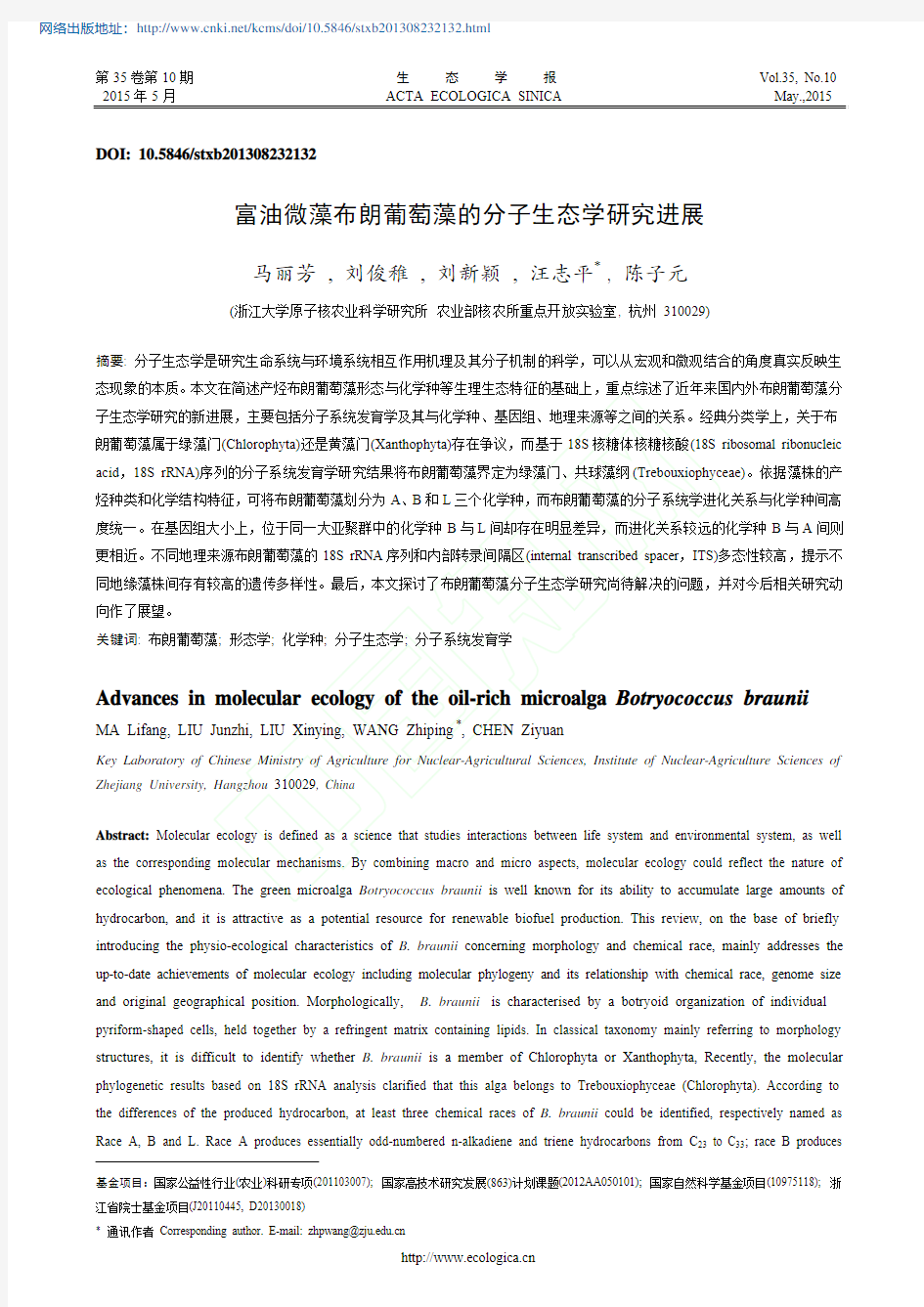富油微藻布朗葡萄藻的分子生态学研究进展汇总.

- 1、下载文档前请自行甄别文档内容的完整性,平台不提供额外的编辑、内容补充、找答案等附加服务。
- 2、"仅部分预览"的文档,不可在线预览部分如存在完整性等问题,可反馈申请退款(可完整预览的文档不适用该条件!)。
- 3、如文档侵犯您的权益,请联系客服反馈,我们会尽快为您处理(人工客服工作时间:9:00-18:30)。
网络出版时间:2014-05-30 10:19
网络出版地址:/kcms/doi/10.5846/stxb201308232132.html
第35卷第10期生态学报Vol.35, No.10 2015年5月ACTA ECOLOGICA SINICA May.,2015
DOI: 10.5846/stxb201308232132
富油微藻布朗葡萄藻的分子生态学研究进展
马丽芳 , 刘俊稚 , 刘新颖 , 汪志平* , 陈子元
(浙江大学原子核农业科学研究所农业部核农所重点开放实验室, 杭州 310029)
摘要: 分子生态学是研究生命系统与环境系统相互作用机理及其分子机制的科学,可以从宏观和微观结合的角度真实反映生态现象的本质。本文在简述产烃布朗葡萄藻形态与化学种等生理生态特征的基础上,重点综述了近年来国内外布朗葡萄藻分子生态学研究的新进展,主要包括分子系统发育学及其与化学种、基因组、地理来源等之间的关系。经典分类学上,关于布朗葡萄藻属于绿藻门(Chlorophyta)还是黄藻门(Xanthophyta)存在争议,而基于18S核糖体核糖核酸(18S ribosomal ribonucleic acid,18S rRNA)序列的分子系统发育学研究结果将布朗葡萄藻界定为绿藻门、共球藻纲(Trebouxiophyceae)。依据藻株的产烃种类和化学结构特征,可将布朗葡萄藻划分为A、B和L三个化学种,而布朗葡萄藻的分子系统学进化关系与化学种间高度统一。在基因组大小上,位于同一大亚聚群中的化学种B与L间却存在明显差异,而进化关系较远的化学种B与A间则更相近。不同地理来源布朗葡萄藻的18S rRNA序列和内部转录间隔区(internal transcribed spacer,ITS)多态性较高,提示不同地缘藻株间存有较高的遗传多样性。最后,本文探讨了布朗葡萄藻分子生态学研究尚待解决的问题,并对今后相关研究动向作了展望。
关键词: 布朗葡萄藻; 形态学; 化学种; 分子生态学; 分子系统发育学
Advances in molecular ecology of the oil-rich microalga Botryococcus braunii
MA Lifang, LIU Junzhi, LIU Xinying, WANG Zhiping*, CHEN Ziyuan
Key Laboratory of Chinese Ministry of Agriculture for Nuclear-Agricultural Sciences, Institute of Nuclear-Agriculture Sciences of Zhejiang University, Hangzhou 310029, China
Abstract: Molecular ecology is defined as a science that studies interactions between life system and environmental system, as well as the corresponding molecular mechanisms. By combining macro and micro aspects, molecular ecology could reflect the nature of ecological phenomena. The green microalga Botryococcus braunii is well known for its ability to accumulate large amounts of hydrocarbon, and it is attractive as a potential resource for renewable biofuel production. This review, on the base of briefly introducing the physio-ecological characteristics of B. braunii concerning morphology and chemical race, mainly addresses the up-to-date achievements of molecular ecology including molecular phylogeny and its relationship with chemical race, genome size and original geographical position. Morphologically, B. braunii is characterised by a botryoid organization of individual pyriform-shaped cells, held together by a refringent matrix containing lipids. In classical taxonomy mainly referring to morphology structures, it is difficult to identify whether B. braunii is a member of Chlorophyta or Xanthophyta, Recently, the molecular phylogenetic results based on 18S rRNA analysis clarified that this alga belongs to Trebouxiophyceae (Chlorophyta). According to the differences of the produced hydrocarbon, at least three chemical races of B. braunii could be identified, respectively named as Race A, B and L. Race A produces essentially odd-numbered n-alkadiene and triene hydrocarbons from C23 to C33; race B produces
基金项目:国家公益性行业(农业)科研专项(201103007); 国家高技术研究发展(863)计划课题(2012AA050101); 国家自然科学基金项目(10975118); 浙江省院士基金项目(J20110445, D2*******)
* 通讯作者Corresponding author. E-mail: zhpwang@
